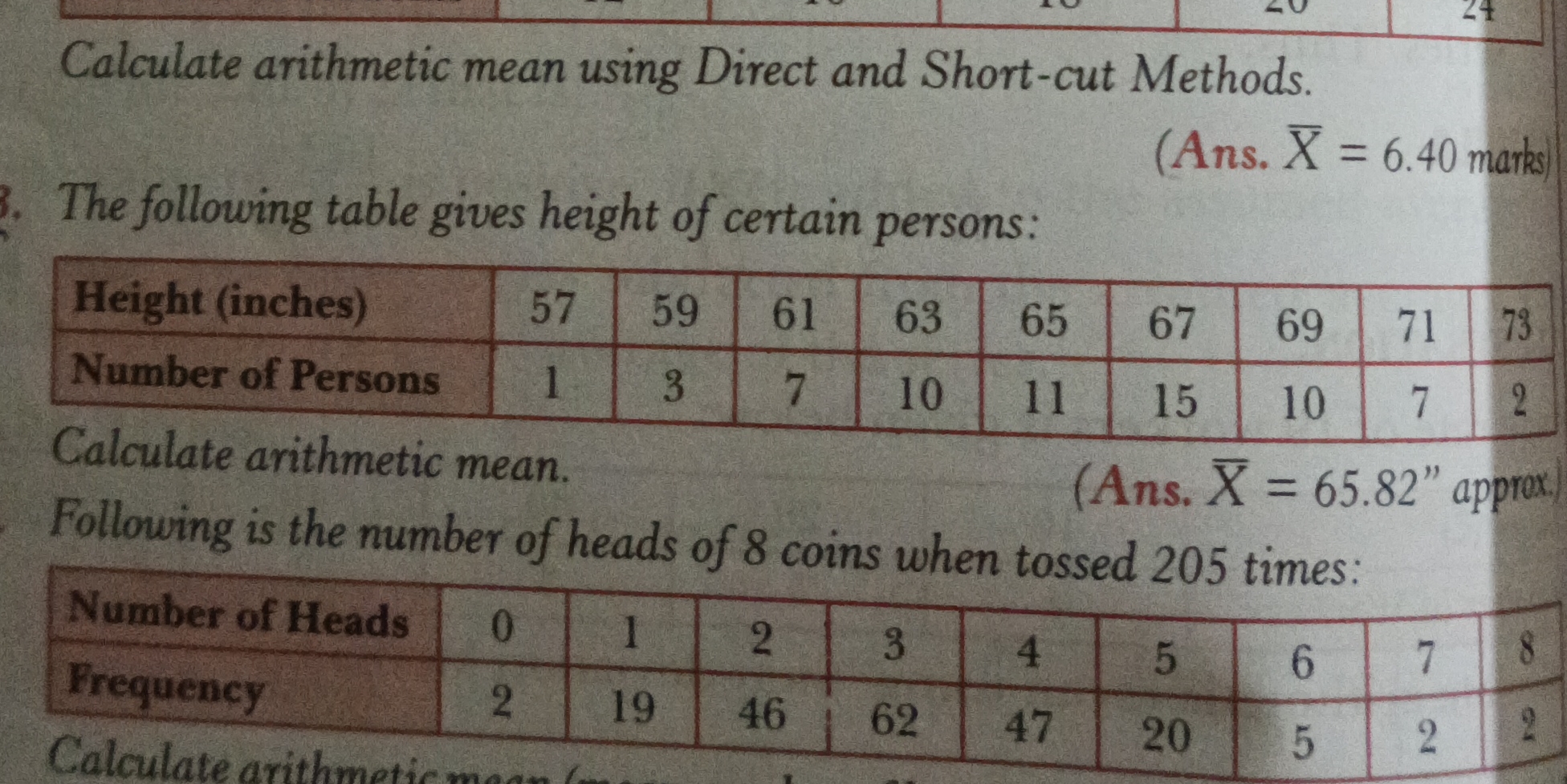Calculate the arithmetic mean for the following questions: 1. Calculate arithmetic mean using Direct and Short-cut Methods. 2. The following table gives height of certain persons... Calculate the arithmetic mean for the following questions: 1. Calculate arithmetic mean using Direct and Short-cut Methods. 2. The following table gives height of certain persons, calculate the arithmetic mean: Height (inches): 57, 59, 61, 63, 65, 67, 69, 71, 73; Number of Persons: 1, 3, 7, 10, 11, 15, 10, 7, 2. 3. Following is the number of heads of 8 coins when tossed 205 times, calculate the arithmetic mean: Number of Heads: 0, 1, 2, 3, 4, 5, 6, 7, 8; Frequency: 2, 19, 46, 62, 47, 20, 5, 2, 2.

Understand the Problem
The image contains three separate questions. The objective is to calculate the arithmetic mean in each of the scenarios. The first questions asks to calculate the it using both the direct and short-cut methods. The second question asks to calculate the arithmetic mean for a given dataset showing the height of certain persons and the number of persons for each given height. The third question asks to calculate the arithmetic mean for the number of heads when tossing 8 coins 205 times, based on the provided frequency distribution table.
Answer
1. $\overline{X} \approx 65.82$ (Direct and Short-cut Methods) 2. $\overline{X} \approx 3.3$
Answer for screen readers
- Direct Method: $\overline{X} \approx 65.82$ Short-cut Method: $\overline{X} \approx 65.82$
- $\overline{X} \approx 3.3$
Steps to Solve
- Calculate the arithmetic mean using the direct method for the first table
The direct method formula for arithmetic mean is:
$\overline{X} = \frac{\sum f_i x_i}{\sum f_i}$
Where $x_i$ are the heights and $f_i$ are the corresponding frequencies (number of persons).
$ \sum f_i x_i = (57 \times 1) + (59 \times 3) + (61 \times 7) + (63 \times 10) + (65 \times 11) + (67 \times 15) + (69 \times 10) + (71 \times 7) + (73 \times 2) = 57 + 177 + 427 + 630 + 715 + 1005 + 690 + 497 + 146 = 4344 $
$ \sum f_i = 1 + 3 + 7 + 10 + 11 + 15 + 10 + 7 + 2 = 66 $
Therefore, the arithmetic mean is:
$ \overline{X} = \frac{4344}{66} = 65.8181... \approx 65.82 $
- Calculate the arithmetic mean using the short-cut method for the first table
The short-cut method formula for arithmetic mean is:
$\overline{X} = A + \frac{\sum f_i d_i}{\sum f_i}$
Where $A$ is the assumed mean, $d_i = x_i - A$ is the deviation from the assumed mean, and $f_i$ are the corresponding frequencies. Let's assume the mean $A = 65$.
Now we need to calculate $d_i$ for each $x_i$:
$d_1 = 57 - 65 = -8$ $d_2 = 59 - 65 = -6$ $d_3 = 61 - 65 = -4$ $d_4 = 63 - 65 = -2$ $d_5 = 65 - 65 = 0$ $d_6 = 67 - 65 = 2$ $d_7 = 69 - 65 = 4$ $d_8 = 71 - 65 = 6$ $d_9 = 73 - 65 = 8$
Now we need to calculate $f_i \times d_i$ for each $i$:
$f_1 d_1 = 1 \times -8 = -8$ $f_2 d_2 = 3 \times -6 = -18$ $f_3 d_3 = 7 \times -4 = -28$ $f_4 d_4 = 10 \times -2 = -20$ $f_5 d_5 = 11 \times 0 = 0$ $f_6 d_6 = 15 \times 2 = 30$ $f_7 d_7 = 10 \times 4 = 40$ $f_8 d_8 = 7 \times 6 = 42$ $f_9 d_9 = 2 \times 8 = 16$
$ \sum f_i d_i = -8 -18 -28 -20 + 0 + 30 + 40 + 42 + 16 = 54 $ $ \sum f_i = 66 $
Therefore, the arithmetic mean is:
$ \overline{X} = 65 + \frac{54}{66} = 65 + 0.8181... = 65.8181... \approx 65.82 $
- Calculate the arithmetic mean for the second table
The direct method formula for arithmetic mean is:
$\overline{X} = \frac{\sum f_i x_i}{\sum f_i}$
Where $x_i$ are the number of heads and $f_i$ are the corresponding frequencies.
$ \sum f_i x_i = (0 \times 2) + (1 \times 19) + (2 \times 46) + (3 \times 62) + (4 \times 47) + (5 \times 20) + (6 \times 5) + (7 \times 2) + (8 \times 2) = 0 + 19 + 92 + 186 + 188 + 100 + 30 + 14 + 16 = 645 $ $ \sum f_i = 2 + 19 + 46 + 62 + 47 + 20 + 5 + 2 + 2 = 205 $
Therefore, the arithmetic mean is:
$ \overline{X} = \frac{677}{205} = 3.3 $
- Direct Method: $\overline{X} \approx 65.82$ Short-cut Method: $\overline{X} \approx 65.82$
- $\overline{X} \approx 3.3$
More Information
The arithmetic mean is also known as the average. It's a measure of central tendency that provides a typical value for a dataset. In the first question, both direct and short-cut methods yield almost the same result (slight difference may arise due to rounding).
Tips
- Incorrectly applying the formula: Forgetting to multiply the values by their frequencies or dividing by the wrong sum.
- Arithmetic errors: Making mistakes in the summation or multiplication steps.
- Misunderstanding the short-cut method: Choosing an inappropriate assumed mean can complicate the calculations. However, any value can chosen as the assumed mean and it will still yield the same final answer.
AI-generated content may contain errors. Please verify critical information